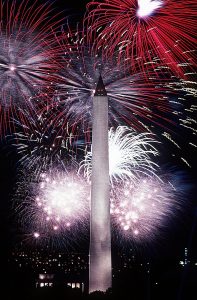
Independence Day is the national day of the United States of America, celebrated on the 4th July when the Declaration of Independence was adopted in 1776. It’s sheer coincidence that it is the day before Tynwald Day which is the national day of my adopted nation, the Isle of Man. It is also the birthday of my younger and most fiercely independent child which is possibly more a matter of fate than coincidence…

In fact, the Continental Congress declared independence two days earlier on July 2 but the declaration was debated and reworded, finally being approved on July 4. The thirteen colonies declared that they were no longer part of the British Empire and regarded themselves as a new nation. The principal author of the declaration was Thomas Jefferson. On 3 July, John Adams wrote to his wife Abigail:
“The second day of July, 1776, will be the most memorable epoch in the history of America. I am apt to believe that it will be celebrated by succeeding generations as the great anniversary festival. It ought to be commemorated as the day of deliverance, by solemn acts of devotion to God Almighty. It ought to be solemnized with pomp and parade, with shows, games, sports, guns, bells, bonfires, and illuminations, from one end of this continent to the other, from this time forward forever more.”

Adams’ prediction was right about everything except the date. Americans chose instead to celebrate Independence Day on the day shown on the Declaration rather than on the date it was actually approved. The day is now a national holiday in the US with huge celebrations including fireworks, parties, picnics and barbecues. Local parades are often held in the morning and families gather to celebrate the long weekend.
I spent some time this week researching the origins of the Manx Tynwald Day without really thinking about the American equivalent, which is funny considering the different sizes of the two nations and two events. Surprisingly, though, there are some similarities in the fierce national pride which both nations take for granted. The Americans chose a date relating to the creation of their state for their national day; the Manx day was simply midsummer, the date when for over 1000 years their national Parliament met in the open air at St John’s to enact the laws passed during the year.
While I am not an advocate for the more aggressive forms of jingoism and the exclusive type of nationalism which can sometimes be associated with the Union Jack flag, I sometimes wish that the English had managed to come up with a national celebration which includes the entire country. We have more than our fair share of ceremonial but it tends to centre on London and the Royal family there and although there are occasional events which pull the country together like the 2012 Olympics and various Royal Jubilees, there is something to be said for a regular day where is is completely acceptable for a person to acknowledge their homeland and their pride to be part of it and it would be nice to feel it was celebrated throughout the UK in the same way that Independence Day is through America.
The Americans have been celebrating Independence Day for just over four hundred years. The Manx have been celebrating Tynwald Day for more than a thousand. It might be a small nation, but that’s what I call history…
